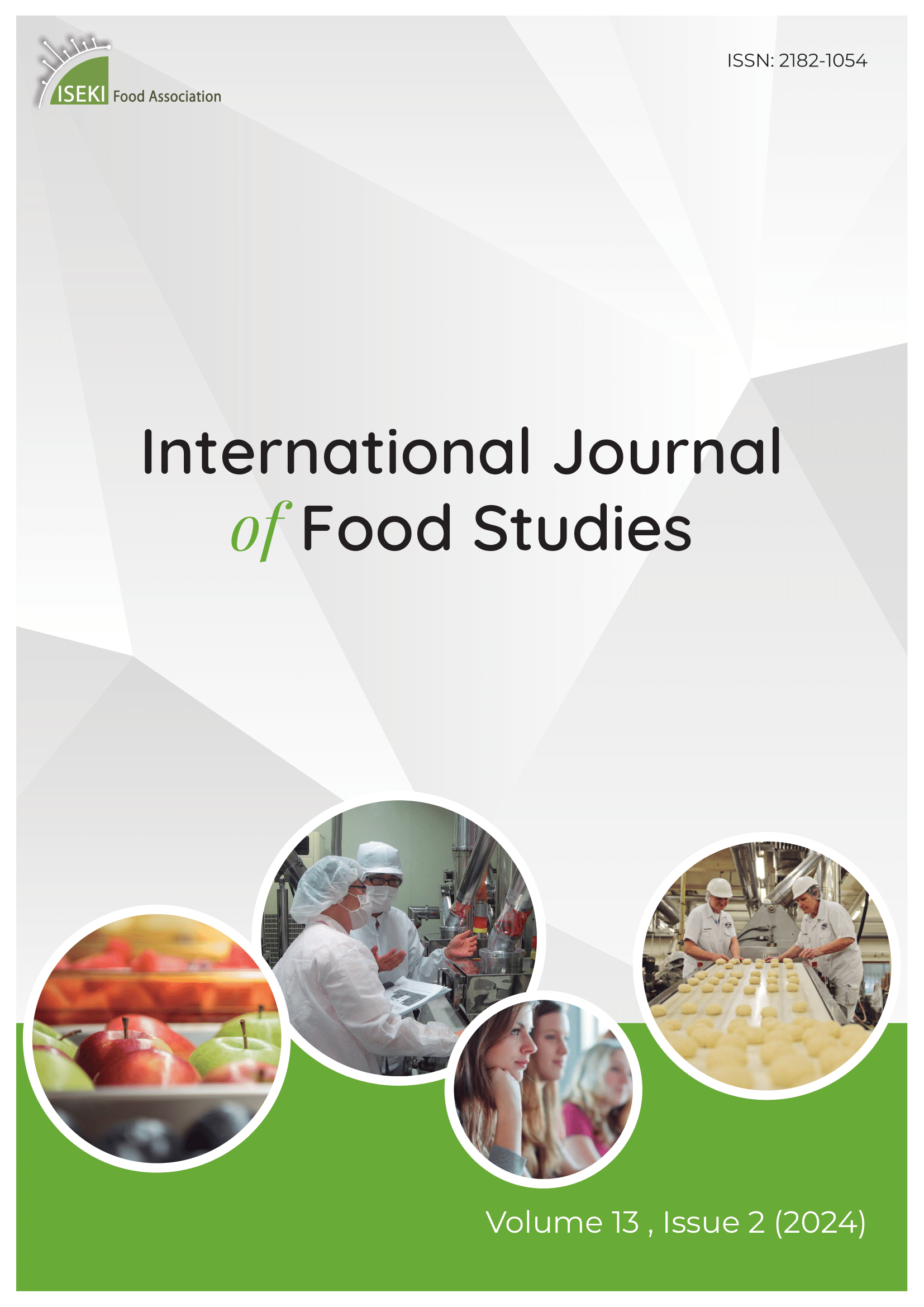Current issue

Volume 13, Issue 2, 2024
Online ISSN: 2182-1054
Volume 13 , Issue 2, (2024)
Published: 18.10.2024.
Open Access
All issues
Contents
18.10.2019.
Original scientific paper
Application of response surface methodology to optimize the drying condition of black tea using superheated steam dryer
Drying conditions of black tea using superheated steam (SHS) were optimized based on a central composite design (CCD) of response surface methodology (RSM). The effects of independent variables (temperature and time) towards the total phenolic content (TPC), scavenging free radical ability, ferric-reducing antioxidant power assay and sensory attributes (infusion colour, aroma, flavour and astringency) were analysed using regression polynomial equations. Analysis of variance (ANOVA) showed that a quadratic model fitted the experimental design well, with a p-value less than 0.05 and a highest coefficient of 0.9474. The optimum drying conditions were achieved at 166.7oC and 21.2 minutes where the experimental values were in accordance with predicted values, with percentage errors (PE) less than 10%. Temperature (140oC – 180oC) was concluded to have the most significant effect and showed a positive direction in most responses. This effect was definitely able to support the application of a SHS dryer for the quality production (antioxidant and sensory properties) of black tea.
Rumaisa Nordin, Norazatul Mohd Rozalli, Tajul A. Yang
18.10.2019.
Original scientific paper
Optimization conditions of UV-C radiation combined with ultrasound-assisted extraction of cherry tomato (Lycopersicon esculentum) lycopene extract
The aim of this work was to study the effect of UV-C radiation on ultrasound assisted extraction (UAE) of cherry tomato bioactive compounds. Cherry tomatoes were exposed to two UV-C radiation doses (0.5 and 1.0 J cm−2 ) and stored at 20 ± 0.5 oC for 7 days. Next, they were lyophilized, and the bioactive compounds were extracted by UAE at 20 KHz. To evaluate the effectiveness of the extraction process of the bioactive compounds, a CCRD (central composite rotational design) was used together with RSM (response surface methodology), for extraction times from 4 to 12 minutes and concentrations (g of lyophilized product / L of ethanol) of 1:10, 1:20 and 1:30. The extracts obtained from the irradiated tomatoes presented 5.8 times more lycopene content than the controls and higher antioxidant activity was obtained for 4 and 8 min, in the concentrations 1:10 and 1:20 (m v −1 ). Through numerical model optimization, optimal extraction conditions were obtained. The results demonstrated that by previously irradiating tomatoes with UV-C light, the UAE yielded considerably higher amounts of lycopene and other bioactives.
Alexandre R. Lima, Nathana L. Cristofoli, Josamaique G. Veneral, Alcilene R. M. Fritz, Margarida Vieira
18.04.2018.
Original scientific paper
Extraction and characterisation of cellulose nanocrystals from pineapple peel
The potential of pineapple peel as a source of cellulose nanocrystals was evaluated. Peels skin from fresh-cut fruit was used as raw material. These residues were purified to remove pigments, lipids and hemicellulose, and a bleaching process for delignification was carried out for 4-6 h. All resulting products were characterised for their lignin, hemicellulose, cellulose and ash contents using standard techniques. Dry matter at the end was low (ca. 50%) compared with the raw material (ca. 90%). The process applied resulted in ca. 20% (m/m) of purified cellulose (ca. 80% purity), with ineligible levels of lignin and hemicellulose present, especially when using 6h of bleaching. The purified cellulose was subject to acid hydrolysis for nanocrystal extraction with two testing times, 30 and 60 minutes. These cellulose nanocrystals had small sizes (< 1000 nm), with high variability and negative zeta potential values. The time of extraction did not affect the nanocrystals’ chemical and physical properties. The use of 6 h of bleaching treatment during purification was shown to be more effective than 4 h. Pineapple peel was demonstrated to be a good source of cellulose for the production of cellulose nanocrystals.
Ana Madureira, Tugba Atatoprak, Duygu Cabuk, Flavia Sousa, Manuela Pintado, Robert C. Pullar
01.12.2017.
Professional paper
Estimating the risk of phthalates exposure via tea consumption in general population
Mohammad Mehdi Amin, Foruz Rastegari, Parinaz Poursafa, Karim Ebrahim
18.04.2018.
Original scientific paper
Optimization of osmotic dehydration of chestnut (Castanea sativa Mill.) slices using Response Surface Methodology
Osmotic dehydration of chestnut slices in sucrose was optimized for the first time by Response Surface Methodology (RSM). Experiments were planned according to a three-factor central composite design (α=1.68), studying the influence of sucrose concentration, temperature and time, on the following parameters: volume ratio, water activity, color variation, weight reduction, solids gain, water loss and normalized moisture content, as well as total moisture, ash and fat contents. The experimental data was adequately fitted into second-order polynomial models with coefficients of determination (R2 ) from 0.716 to 0.976, adjusted-R2 values from 0.460 to 0.954, and non-significant lacks of fit. The optimal osmotic dehydration process conditions for maximum water loss and minimum solids gain and color variation were determined by the “Response Optimizer” option: 83% sucrose concentration, 20 °C and 9.2 hours. Thus, the best operational conditions corresponded to high sugar concentration and low temperature, improving energy saving and decreasing the process costs.
Teresa Delgado, Bruna Paim, Jose Alberto Pereira, Susana Casal, Elsa Ramalhosa
18.10.2018.
Original scientific paper
Antioxidant activities of aqueous extracts from nine different rose cultivars
Rose petals have been applied as food additives in teas, cakes and flavor extracts. The aim of this research study was to explore and reveal the antioxidant potential of aqueous extracts of rose petals belonging to nine genotypes of rose (wild as well as hybrid). The in vitro antioxidant activities of roses were studied by lipid peroxidation assay, DPPH radical scavenging assay, iron chelation assay, phosphomolybdenum reduction assay and total phenolic and flavonoid contents. The aqueous extract showed inhibition against lipid peroxidation (TBARS), induced by prooxidants (10 µM FeSO4) in mice liver homogenate. The free radical scavenging activities of the extracts were determined by scavenging of the DPPH radical. Extracts also showed metal chelating activities and high antioxidant activity in the phosphomolybdenum assay. The high content of phenolics and flavonoids detected in aqueous extracts may be responsible for the antioxidant activity. Amongst the different rose genotypes, screened, Rosa moschata (musk rose) was found to carry slightly higher antioxidant potential, owing to its higher phytochemical content.
Hamadia Khurshid, Syed Mubashar, Shahid Iqbal Awan, Syed Rizwan Abbas, Muhammad Irshad
01.12.2017.
Professional paper
Energy pattern and conservations of condiment produced from soybean (Glycine max)
Ismaila B. Anjorin, Rahman Akinoso, Mayowa S. Sanusi
18.10.2018.
Original scientific paper
Antioxidant and antibacterial activities of exopolysaccharides produced by lactic acid bacteria isolated from yogurt
The objectives of this study were to optimize the conditions for cell growth and exopolysaccharides (EPS) production by using pure and mixed microbial cultures of Streptococcus thermophilus and Lactobacillus bulgaricus, and to evaluate the antioxidant and antibacterial activities of EPS in vitro. The mixed cultures of two strains showed a higher cell growth whereas the higher EPS production was detected in pure culture with S. thermophilus. The optimal medium were determined as follows (g/l): sucrose 50, yeast extract 10, KH2PO4 3 , MgSO4.7H2O 0.05 and pH initial 6.5 at 30°C. Under the optimized conditions, the values of dry cell weight (DCW) and EPS were 5.2± 0.8 g/l and 56.8 ± 0.62 mg/ml, respectively. The EPS demonstrated a positive antioxidant potential on DDPH radical scavenging. The agar diffusion assay showed that purified EPS exhibited antibacterial activities against tested pathogens such as Escherichia coli ATCC 250922 and Staphyloccocus aureus ATCC 250923 at (62-1000) μg/mL. In conclusion, EPS have an antioxidant activity and could have applications in the food industry.
Benattouche Zouaoui, Djillali Bouhadi, Ghalem Bachir Raho
18.10.2018.
Original scientific paper
‘Made-in-transit’ yoghurt processing: a review of basic concepts and technological implications
The manufacture of food during distribution, a concept known as “made-in-transit” (MIT) manufacture, has the potential to expand the distribution range, extend shelf-life, and provide the customer with the freshest possible product. Benefits for the manufacturer include maximising throughput while minimising manufacturing space and inventory. This concept is new, with mushrooms being the only MIT food developed so far. The feasibility of developing an MIT product from a fermented food was reviewed using yoghurt as a model system. Through the alteration of some of the yoghurt manufacturing parameters (e.g. milk base formulation, heat treatment, starter culture composition and fermentation temperature) it is possible to develop this form of yoghurt production. A predictive microbiology approach is suitable for predicting the effects of both time and temperature on designing and predicting the fermentation process. This review demonstrates the potential of the MIT concept for a fermented food.
Nor Khaizura Mahmud Ab Rashid, S. H. Flint, O. J. McCarthy, J. S. Palmer, M. Golding, A. Jaworska
18.10.2018.
Original scientific paper
Food safety implementation in the perspective of network learning
The food sector frequently faces difficulties in implementing food safety standards. Indeed, there are many barriers to appropriation of quality management standards which make effective implementation difficult for small and medium enterprises (SMEs), such as limited access to information, lack of financing and cognitive resources, food hazard perception, and insufficient access to adequately trained personnel. Consequently, one fundamental objective for practitioners such as managers, public bodies and development agencies is to help these food SMEs in improving their implementation capacity, which is usually done through the launch of different forms of collective initiatives such as associations, clubs, learning platforms, regional actions and other forms of collaboration. Globally speaking, the objective of these initiatives typically is to develop a step by step approach providing guidance on good practices associated with the implementation of these systems. The objective of the article is to explore and test the validity of this hypothesis, rooted in a general idea of “organizational network learning”: the capacity of SMEs to adopt new food safety schemes is seen as a whole and necessitates mobilizing, at the same time, 1) formal innovation networks, which bring cognitive resources and institutional credibility, and 2) the practice by managers of informal network activities through interactive exchanges of information, benchmarking, knowledge transfer and translation, and experiential learning.
Zam-Zam Abdirahman, Leslie D. Bourquin, LOIC SAUVEE, Deepa Thiagarajan











